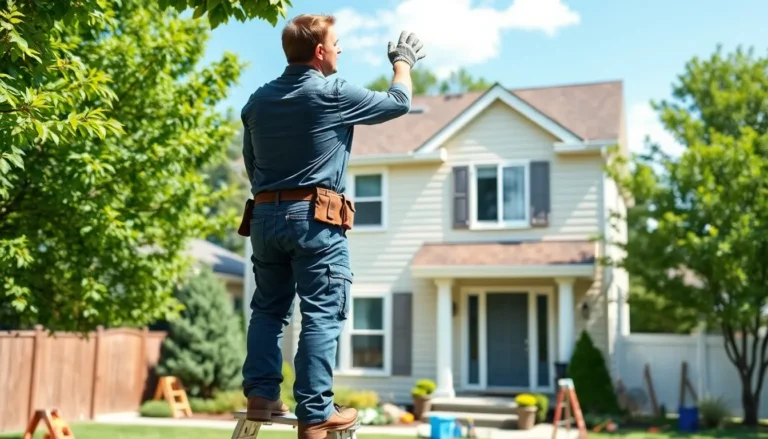Imagine a world where your home not only knows when you’re cold but also ensures your wallet stays warm. With smart home technology, that dream’s a reality. These clever gadgets aren’t just about convenience; they’re your new best friends in slashing energy bills and saving the planet—one quirky device at a time.
From smart thermostats that learn your habits to energy-efficient appliances that practically run themselves, the future of home energy savings is here, and it’s more entertaining than a cat video. By embracing these innovations, homeowners can enjoy increased comfort while waving goodbye to those pesky high utility bills. So, let’s dive into how these smart solutions can turn your home into an energy-saving powerhouse.
Table of Contents
ToggleUnderstanding Smart Home Energy Savings
Smart home energy savings refers to the technique of using advanced technology to enhance energy efficiency within a home. By integrating smart devices, homeowners can significantly lower energy consumption and costs.
Definition and Importance
Smart home energy savings involves using connected devices to monitor and control energy usage. This approach is crucial for reducing electricity bills and minimizing environmental impact. Enhancing energy efficiency contributes to a sustainable lifestyle. Homeowners save money through automated energy management and data-driven insights. Additionally, smart homes support the integration of renewable energy sources, improving overall energy independence.
Key Components of Smart Homes
Several key components comprise smart home energy systems. Smart thermostats adjust heating and cooling based on occupancy patterns, optimizing energy usage. Energy-efficient appliances consume less power compared to traditional models, contributing to significant savings. Smart lighting systems allow homeowners to control brightness and schedules remotely, reducing unnecessary energy consumption. Energy monitoring systems provide real-time feedback on usage, enabling better decision-making. These components work together, creating an integrated system that maximizes energy efficiency while enhancing daily living.
Benefits of Smart Home Energy Savings
Smart home energy savings yield significant advantages for both homeowners and the environment. By leveraging advanced technology, individuals can maximize energy efficiency and reduce utility costs.
Cost Reduction
Cost reduction stands as a primary benefit of smart home technology. Smart thermostats adjust heating and cooling based on user habits, leading to savings of up to 30% on energy bills. Energy-efficient appliances consume less electricity without sacrificing performance. Additionally, automated lighting systems prevent unnecessary usage by turning off when rooms are unoccupied. Users can monitor energy consumption through smart devices, allowing them to identify wasteful patterns. These strategies combined ensure that homeowners realize decreased utility expenses over time.
Environmental Impact
Environmental impact represents another crucial advantage of smart home energy savings. Lower energy consumption diminishes greenhouse gas emissions, promoting sustainability. Smart home systems optimize energy use, contributing to reduced demand for fossil fuels. Many smart devices also utilize renewable energy sources, enhancing their eco-friendliness. Furthermore, improved energy efficiency leads to conservation of resources, benefiting the planet’s overall health. Collectively, these actions foster a more sustainable lifestyle, essential for future generations.
Technologies Driving Smart Home Energy Savings
Innovations in technology drive the potential for significant energy savings in smart homes. These advancements optimize energy consumption, enhance user convenience, and contribute to environmental sustainability.
Smart Thermostats
Smart thermostats adjust the heating and cooling of homes based on occupancy and preferences. By learning user habits, these devices optimize temperature settings, leading to energy savings of up to 30%. Programmable features allow for automatic temperature changes at specific times, promoting efficiency while maintaining comfort. Newer models integrate with home automation systems, providing remote control via smartphones or tablets. Many smart thermostats also offer energy reports, helping users understand their energy usage patterns and make informed choices.
Energy Monitoring Systems
Energy monitoring systems provide real-time insights into household energy consumption. These systems track usage across various devices, enabling homeowners to identify energy hogs and reduce waste. Alerts notify users of unusual spikes in energy use, prompting timely action. Integration with smart home ecosystems allows for automated adjustments, discouraging excessive consumption. Reports generated by monitoring systems outline trends and help prioritize energy-saving actions, thereby maximizing energy efficiency.
Strategies for Implementing Smart Home Energy Savings
Smart home energy savings involve a variety of strategies that enhance efficiency. Homeowners can adopt specific methods to maximize energy usage and reduce costs.
Auditing Energy Use
Conducting an energy audit reveals patterns in consumption. Homeowners can identify peak usage times and high-energy appliances. An audit helps pinpoint areas needing improvement, leading to targeted energy-saving efforts. Measuring energy performance empowers users to track progress and make necessary adjustments. This analysis enables decision-making that directly impacts savings and environmental benefits.
Choosing the Right Devices
Selecting appropriate smart devices enhances energy efficiency. Smart thermostats adjust heating and cooling automatically based on occupancy. Energy-efficient appliances use less power while delivering high performance. Smart lighting solutions provide options like dimming and scheduling to cut down on waste. Utilizing energy monitoring systems to track usage trends enables insights into specific consumption patterns, promoting informed choices. Prioritizing devices that align with individual needs ensures maximum savings and satisfaction.
Challenges and Considerations
Smart home energy savings present various challenges that homeowners must address. Awareness of these challenges fosters better decision-making.
Initial Investment
Smart home technology often requires an upfront investment. For example, smart thermostats and energy-efficient appliances can range from $100 to $300 each. Upfront costs may deter some homeowners, despite potential long-term savings. Planning ensures homeowners select the right technologies that maximize energy efficiency. Budgeting for initial expenditures ultimately leads to greater savings on energy bills over time.
Compatibility Issues
Ensuring device compatibility is crucial for a seamless smart home experience. Some homeowners face challenges integrating new devices with existing systems. For instance, smart thermostats may not work with older HVAC systems without adapters. It’s important to research compatibility before purchasing new products. Many manufacturers provide compatibility lists to aid selection. Addressing these issues early streamlines energy management efforts, enhancing overall efficiency.
Smart home energy savings represent a significant opportunity for homeowners looking to reduce costs and promote sustainability. By integrating advanced technologies, individuals can optimize their energy consumption while enjoying enhanced comfort and convenience. The right smart devices not only lower electricity bills but also contribute to a healthier planet by minimizing environmental impact.
As homeowners embrace these innovations, they can take control of their energy usage and make informed decisions that lead to long-term benefits. Investing in smart technology may require an initial commitment, but the potential savings and positive environmental effects make it a worthwhile endeavor. With the right approach, transforming a home into an energy-efficient haven is not just achievable but also immensely rewarding.




